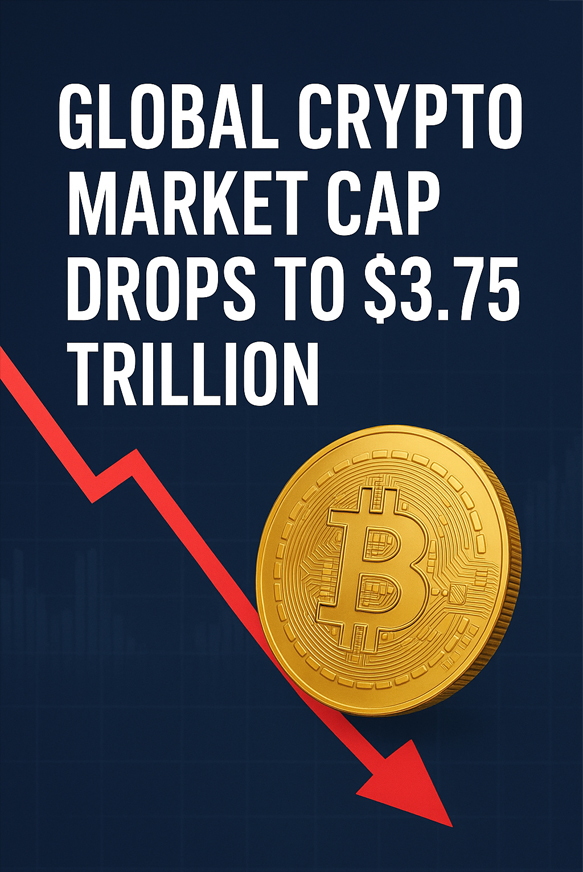Premium Biz Post – The cryptocurrency market is once again under pressure. According to the latest reports, the global crypto , marking a notable decline from the previous week’s valuation. This downward movement has stirred conversations among investors and analysts alike, as uncertainty in both regulatory frameworks and macroeconomic conditions continues to weigh heavily on digital assets.

A Week of Volatility in the Crypto Space
Over the past several days, major cryptocurrencies such as Bitcoin, Ethereum, and Binance Coin have all experienced sharp fluctuations. Bitcoin, the world’s largest digital currency, dropped below $110,000 after touching a new high earlier this month. Ethereum also slipped, trading near the $5,400 mark, while other altcoins like Solana, Cardano, and Avalanche recorded losses between 3% and 7%.
Experts attribute this pullback to a combination of global economic pressure and shifts in investor sentiment. The U.S. Federal Reserve’s cautious stance on interest rates, coupled with continued inflation concerns, has led many institutional investors to reduce exposure to high-risk assets, including cryptocurrencies.
Meanwhile, the growing preference for traditional safe-haven investments like gold and government bonds further adds to the sell-off pressure in digital markets.
Investor Sentiment Turns Cautious
Market analysts suggest that investor sentiment is becoming increasingly cautious. Despite strong technological and institutional adoption, the crypto sector remains highly sensitive to changes in market mood. Many traders now prefer short-term positions rather than long-term holdings, hoping to minimize exposure to sudden downturns.
Some exchanges have also reported a decline in trading volumes, signaling a temporary retreat from speculative trading. At the same time, stablecoins such as USDT and USDC saw increased inflows, suggesting that investors are moving funds to less volatile assets while waiting for clearer market signals.
Michael Levin, a financial strategist at CryptoCompare, commented,
“This market cycle shows how quickly confidence can shift. We’re seeing an environment where macroeconomics and regulation are dictating sentiment more than innovation or technology.”
Regulatory Pressure Intensifies
Another key factor behind the recent dip is tightening regulation. Governments and financial authorities worldwide have accelerated their efforts to establish clearer rules for the crypto industry. In the United States, the Securities and Exchange Commission (SEC) continues to pursue actions against non-compliant exchanges and tokens deemed as unregistered securities.
Similarly, the European Union has strengthened its Markets in Crypto-Assets (MiCA) framework, requiring more transparency and stricter compliance. While many industry participants welcome these developments for their potential to legitimize the space, the short-term impact tends to generate uncertainty among investors.
Asia is also tightening oversight. Singapore’s Monetary Authority (MAS) recently warned retail investors about speculative risks in crypto trading. In Japan, exchanges are under increasing scrutiny for anti-money-laundering compliance. These developments have collectively added pressure on crypto prices, even as innovation continues to thrive in DeFi, Web3, and blockchain technology sectors.
Read More : ”DIY Transparent Aromatherapy Soap A Beautiful, Fragrant, and Skin-Loving Creation”
Bitcoin and Ethereum Lead Market Movements
Bitcoin’s recent dip below $110,000 has been one of the biggest drivers of market sentiment. As the flagship asset, Bitcoin often acts as the benchmark for the entire crypto ecosystem. When Bitcoin weakens, other assets tend to follow.
Ethereum, the second-largest cryptocurrency, has also shown signs of exhaustion after a strong rally earlier in the year. Despite positive developments like Ethereum 3.0 testing and scaling improvements, the broader sell-off has overshadowed its technical progress.
Altcoins have suffered even more. Memecoins such as Dogecoin and Shiba Inu have lost a significant portion of their earlier gains, while layer-2 tokens like Arbitrum and Optimism are trading near their monthly lows. Analysts warn that speculative tokens could face the sharpest corrections if market sentiment continues to decline.
Institutional Adoption: A Silver Lining
Despite the bearish momentum, institutional adoption remains one of the most encouraging aspects of the current market. Major financial institutions continue to explore crypto custody, tokenization, and blockchain-based payment systems.
Investment firms such as BlackRock, Fidelity, and Grayscale have maintained their digital asset divisions, even expanding some of their services in response to client demand. The emergence of spot Bitcoin ETFs in multiple countries has further validated crypto as a legitimate asset class for diversified portfolios.
In addition, corporate adoption continues to grow. Companies in sectors like gaming, fintech, and e-commerce are integrating blockchain solutions to enhance transparency and reduce transaction costs. While prices fluctuate, the underlying technology continues to evolve and gain real-world utility.
AI, Blockchain, and the Next Digital Shift
One of the most interesting intersections in 2025 is the growing connection between artificial intelligence and blockchain technology. AI-driven trading bots, decentralized AI data marketplaces, and tokenized computation power are redefining what digital assets can achieve beyond speculation.
Projects like Fetch.ai and Ocean Protocol are already leveraging AI to make decentralized systems smarter and more efficient. This convergence could represent the next major wave of digital innovation—potentially sparking renewed investor interest once market stability returns.
The Role of Regulation in Shaping the Future
For many experts, regulation is not necessarily a threat but rather a necessary evolution. Clearer policies can help reduce fraud, improve transparency, and attract institutional capital. Without regulatory clarity, the crypto market often becomes vulnerable to manipulation and speculative excesses.
Countries that adopt balanced frameworks—neither too restrictive nor too permissive—are likely to become the next global crypto hubs. For instance, the United Kingdom’s push to create a “Digital Asset Economy” under defined legal guidelines has drawn attention from blockchain startups seeking regulatory certainty.
Similarly, Indonesia, South Korea, and the UAE are positioning themselves as progressive crypto markets by introducing sandbox programs and tax incentives for blockchain businesses. Such developments could offset negative trends in the short term by building stronger foundations for long-term growth.
Market Outlook: Short-Term Pain, Long-Term Gain
While the current correction may appear alarming, many analysts see it as a natural phase in the broader market cycle. Historically, the crypto market has experienced several deep corrections followed by strong recoveries. These downturns often serve as a “reset” mechanism, flushing out overleveraged traders and paving the way for more sustainable growth.
Some investors even view the current dip as a buying opportunity. With global adoption and technological innovation accelerating, long-term prospects remain promising. The only uncertainty lies in how quickly the market can regain confidence.
“Volatility is part of crypto’s DNA,” said analyst Emma Rodriguez from ChainBase Research.
“But every cycle of decline brings more maturity, better infrastructure, and smarter investors.”
Practical Advice for Investors
- Stay Informed: Follow reliable crypto news sources and regulatory updates.
- Diversify Investments: Avoid concentrating all funds in a single asset or exchange.
- Use Secure Wallets: Protect your holdings with hardware or reputable digital wallets.
- Avoid Emotional Trading: Fear and greed can lead to costly mistakes.
- Think Long Term: Short-term volatility often hides long-term opportunity.
By keeping these principles in mind, investors can navigate uncertainty with more confidence and resilience.
The current dip in market capitalization highlights the evolving nature of digital assets. The fact that the global crypto market cap drops to $3.75 trillion Trillion underscores both the fragility and dynamism of this young financial ecosystem. While short-term traders may feel the pressure, long-term investors and innovators continue to see crypto as a transformative force that will redefine finance, governance, and technology.



